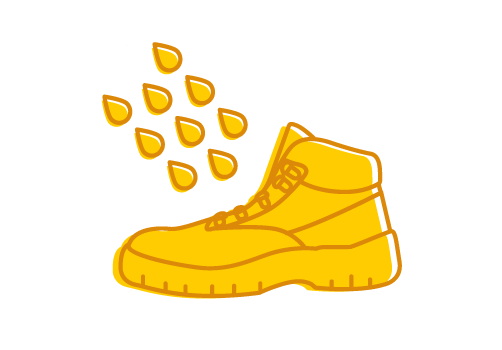It is important to take time to care for your safety footwear. Proper care will add to the lifespan of your footwear, it should ensure that the maximum comfort level is maintained for longer, and that hygienically, your shoes or boots do not contribute to health problems.
Footwear Care Guidelines

safety footwear care tips
- Avoid scuffing the upper leather or treading on sharp edges that could cut or tear the sole.
- Clean your shoes regularly.
- Remove excess mud and dirt and wipe clean with a damp cloth and allow drying thoroughly, preferably overnight at room temperature.
- Never force dry your footwear if they become wet, as direct heat may distort the upper and cause the leather to crack.
- If your footwear has a leather upper apply a good quality wax polish or shoe cream regularly.
- If your footwear has a Nubuck or suede upper it should be gently rubbed with a stiff bristled brush.
- Soles should be checked regularly and stones and metal shavings removed from the cleats.
- If the laces become worn, replace immediately to ensure a good fit.
It is very important to note that damaged footwear will not provide the necessary protection you require, and they should be replaced immediately if not in the suitable condition to protect your feet.

Lifespan of Safety Footwear
There is no set guide for how long your footwear will last. It depends on the environment in which it has been used and stored.

Storing of boots and the risk of Hydrolysis
Most safety footwear (including REBEL) soles are made from polyurethane (PU). PU has the right mix of abrasion resistance, lightweight properties and cost effectiveness. However, PU is a chemical compound which can degrade over time if it is not used regularly, or if it is stored in a dark and/or humid environment without regular use. If your boots have sat unused for a long period of time (approx. three years) and then you start using them again, there is a high risk that the sole may disintegrate, which is known as HYDROLYSIS. We cannot be held responsible for this disintegration if it results from long periods of storage.

Water Damage
Most safety footwear is made from leather. Leather is NOT waterproof, or water-resistant, unless it has been specifically treated.
If your boots are repeatedly exposed to water and mud, and they are not listed as water-resistant, they will eventually crack. We will view this as improper use, and will not replace any shoes which have become damaged as a result. If you polish your boots regularly, then the polish will protect against occasional – NOT regular water exposure.
